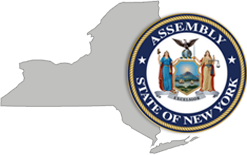A05050 Summary:
| BILL NO | A05050 |
| SAME AS | No Same As |
| SPONSOR | Jacobson |
| COSPNSR | Simon |
| MLTSPNSR | |
| Amd §49, UDC Act | |
| Requires state and municipal facilities program grants be issued only with governor, senate or assembly sponsor. | |
A05050 Memo:
Go to topNEW YORK STATE ASSEMBLY
MEMORANDUM IN SUPPORT OF LEGISLATION
submitted in accordance with Assembly Rule III, Sec 1(f)
TITLE OF BILL: An act to amend the New York state urban development corporation act, in relation to the state and municipal facilities program PURPOSE OR GENERAL IDEA OF BILL: The bill would require members of the state legislature to take respon- sibility for money directed to local governments through the State and Municipal facilities (SAM) program by prohibiting anonymous SAM grants. SUMMARY OF PROVISIONS: Section 1: Amends the urban development corporation act to add a new subdivision 4 requiring that any grant issued as part of the state and municipal facilities program shall be sponsored by the governor or shall have a sponsor from the state senate or the state assembly. Section 2 sets forth the effective date which is immediately and shall be deemed to have been in full force and effect on and after April 1, 2025. JUSTIFICATION: State legislators can funnel money to local governments through the State and Municipal facilities program (SAM) but currently, SAM grants are not required to have a sponsor in the State Senate or Assembly. Requiring transparency in spending public money is a vital good govern- ment reform. PRIOR LEGISLATIVE HISTORY: 2019-2020: A8233-A - Amend and recommit to Assembly Environmental Conservation Committee 2021-2022: A695 - Referred to Assembly Environmental Conservation Committee S1845 - Referred to Senate Corporations, Authorities and Commissions Committee 2023-2024: A858 - Referred to Assembly Environmental Conservation Committee S441 - Referred to Senate Corporations, Authorities and Commissions Committee FISCAL IMPLICATIONS: None. EFFECTIVE DATE: This act shall take effect immediately and shall be deemed to have been in full force and effect on and after April 1, 2025.
